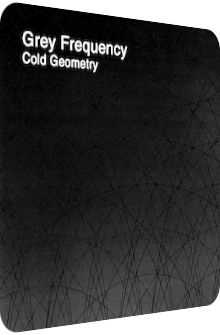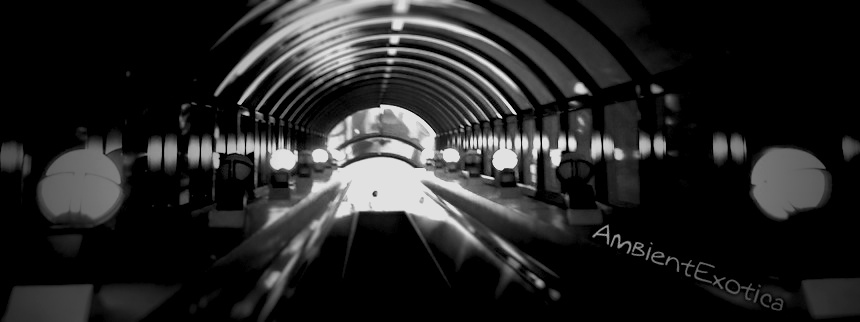
Grey Frequency
Cold Geometry
2013
Cold Geometry is the sophomore album of Nottingham-based artist Grey Frequency, self-released in both a tape edition and digital download version in September 2013, available to purchase and fully streamable at Bandcamp. Spanning six tracks of densely layered drones and windy field recordings, an album title like Cold Geometry does actually hint at a Glitch nucleus or an – don’t hate me for the following genre term – IDM-focused approach, but this is not the case, there is anything on board that would be related to these genres. In lieu of this avantgarde coruscation, Grey Frequency intermingles two of my favorite genres and becomes part of a movement that recently celebrated its resurrection and has always been kind of "there," if not necessarily in the realms of music. Dark Ambient is one of the genres I am talking about, and the one already well-known, consisting of screeching electric guitar twangs, field recordings of bubbling swamps as well as alloys of hazy tape hiss. This base frame or blueprint becomes ennobled, however, as it faces the wondrous ingredients of Hauntology. It is the latest trend, but here to stay, even though its qualities are hard to pinpoint. It is closely related to Dark Ambient, but does not necessarily sport mean-spirited tones in minor. Instead, respective artists such as Joseph Curwen, Antidröm, Eyesix and, of course, Grey Frequency, often present their vignettes and insights without a clear-cut set of harmonies. They create rooms, jinxed forests or try to capture the haunting enigmas of real-world locations or sites of crime via found sounds. This is exactly where Cold Geometry comes into play. With the exception of a few terrifying ingredients, everything feels comparably noble and gentle, which implies that there are no cheap shockers, sudden eruptions or demons bursting into the scene. While not a work of horror per se, uneasiness, portent and the things one seems to hear or uncover are the most frightening and chilling efforts. Does Cold Geometry deliver in this regard?
The opener Dusk Gives Way To Night sets both the color and mood range of Grey Frequency’s album. It is undoubtedly cold: gloomy drone washes, probably made of stringed but mercilessly processed instruments twirl through the aural landscape. And dark they are alright. Whereas The Orb’s polyhedric Ambient hit O.O.B.E. off U.F.Orb (1992) launches with faux-abysmal bass protrusions aquiver with pleasure and in the know of the technicolor scintillae to come, Dusk Gives Way To Night resembles the physiognomy of a brute that hides in the dun-colored shade. Ameliorated by electric guitars and eerie wind gusts, it truly lives up to its title. The storm increases, but never rises to unbearable levels. The interstices are crepuscular, the airflow whirls through the clefts. As any prime example of a Drone song, it does not feature real melodies in the classical sense; it is even hard to hum along to it. Dusk Gives Way To Night is a Dark ambient piece complete with hauntological particles, peaceful yet stormy. Gyrating around a genteel turmoil in the open country and ominous cellars, it remains a mystery.
The follow-up Dyatlov Pass is hazier. But there is much more to it: it unchains a masked insouciance loaded with a perversely uplifting warmth that is embroidered in the track’s diffuse fibers. The omnipresence of a lucid dream is evoked, or rather invoked. The stokehold atmosphere is surprisingly mellow, possibly mephitic and very dense, but non-hazardous. A perfectly – and positively – streamlined track which seems like a plateau until it reaches its final third, where gunshots and cannons fly through the air, completely hazy and blurry, and thankfully so. The listening subject watches and hears the war from afar. A fake choir of lost souls rounds off the dichotomy. One can feel safe, but definitely not sound. Rainhill then unfolds a fantastic plasticity which has to be heard to be believed. Croaking wood, midnight bells, the rhythmical, semi-brazen unnerving sound of a walking cane (or truncheon?) altogether hail through the darkness. The gongs contain an ashen hollowness, a portentous creepiness. Diffuse rain and mild sirens in the shapes of electric guitars make this a damp, hopelessly forsaken place with a superb depth. Frightening for Pop Ambient fans, true, but a feast for followers of the Hauntology-interspersed Folk movement.
The next stop is called Signal And Serenade. It is very aqueous and windy, with multitudes of low frequency rumblings sewn into the chaparral. There is a reason why the title sports the word serenade, and a good one it is too, as there are ethereally yearning strings à la John Adams (not John Carpenter) which emit cavalcades of amicable beams. These illumine the bone-crushing scenery and make it bearable. Otherwise, this track does actually live up to the artist’s name and sports a light-gray aura between a very mild timbre. If one track can be described as wondrous and fairy tale-like – in the given context and endemics of the album – then it must be Signal And Serenade. However, it is Future Ghosts Past which plays fair and does not even hide its hauntological background, neither via its textural pool nor the supernatural references of its title. The longest track of almost ten minutes, it is at first paradoxically mellow. Whether it is the frizzling fricatives, whispered click consonants or heterodyned string impositions, everything is foggy yet perniciously bustling. Do the whispers contain satanic subtexts? During its apex, Future Ghosts Past reveals a female voice talking about attention and timeless entities, but her voice is never too comforting, let alone mollifying. The textural progression of the drone structures happens only cautiously, a sudden moment of hamartia or other harmful insights do not materialize. The finale, named Counting Decibels, is ye goode olde ode to the engine room and further improved by partially crystalline sine tone coils. Windy, dusty and cramped at the same time, it is all about benign Industrialism complete with bouncing metallic clangs and aerose surfaces. The endpoint of Cold Geometry focuses yet again on the stealth side, the artificial architecture rather than nature. Is that a good thing? Appraising adjectives never helped in the context of horror, nor do they now.
Cold Geometry is a skillful Drone work with clefts and fissures that serve as vestibules for falsetto tones, various kinds of winds and – who would have thought – lost souls which waft through the highlands, valleys and dungeons. This can be said about many hauntology-driven or -influenced Ambient works, but Grey Frequency manages to cherish and keep one important thing alive throughout the runtime of his sophomore album: stringency. Alternatively, let us call it balance or cohesion, but these terms all lead to the same phenomenon, namely a harmonious concept. That only the concept is harmonious, but not the frightening and daemoniac textures, is a seal of quality. And yet, these very textures are not alatoric or arbitrary either, but resemble the album title. Natural winds, gaseous-thermal cloudlets caused by machines and last but not least, clicking and clanging iron-based surfaces meet, mesh and depart throughout Cold Geometry. I can think of another qualitative aspect, and that is the cautious creation of uneasiness. The listening subject is neither a victim nor in a hopeless situation; Grey Frequency lets his compositions be. They flow, float and waft. They are not depicting a madman’s dream or a sickening procession. Everything is presented as is. I am no expert in Hauntology and do not even know whether Grey Frequency shakes his head in disdain due to the continuous appearance of this trigger term, but it is important to me to carve out the distinction, for Cold Geometry is no Dark Ambient album, as there are light sources in Signal And Serenade. Then again, there are creepy whispers found in Future Ghosts Past. To every action must be a reaction. The sums on each side, meanwhile, are identical. This is why Cold Geometry is a very intriguing tape, not created to shock and harass the listener, but to show him or her bleak, dense nocturnal sceneries that do inherit and emanate wonders and beauty. If the last sentence makes sense to you, then check out this grey quartz!
Further listening and reading:
- You can purchase and fully stream Cold Geometry at Bandcamp.
- Grey Frequency is on Twitter: @GreyFrequency.
Ambient Review 280: Grey Frequency – Cold Geometry (2013). Originally published on Nov. 6, 2013 at AmbientExotica.com.
